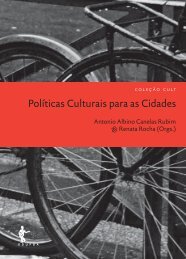Culture in for and as Sustainable Development
YIGflg
YIGflg
You also want an ePaper? Increase the reach of your titles
YUMPU automatically turns print PDFs into web optimized ePapers that Google loves.
Multiple contributions of culture to<br />
susta<strong>in</strong>able development<br />
The overall issue is a need to make<br />
culture more explicit <strong>in</strong> the academic<br />
<strong>and</strong> policy debate on susta<strong>in</strong>able<br />
development: I refer here to a view<br />
of culture <strong>in</strong> <strong>and</strong> <strong>for</strong> susta<strong>in</strong>able<br />
development which is understood<br />
<strong>in</strong> dynamic <strong>in</strong>teraction with nature.<br />
<strong>Culture</strong>, <strong>as</strong> an ensemble of tangible<br />
vectors of social life, comprises a<br />
natural dimension. It is this dimension<br />
that should be resurrected <strong>in</strong><br />
order to strengthen <strong>and</strong> make more<br />
tangible the role of culture <strong>in</strong> susta<strong>in</strong>able<br />
development.<br />
(Constanza Parra)<br />
SEVEN STORYLINES OF CULTURAL<br />
SUSTAINABILITY<br />
In their paper <strong>in</strong> GeoForum [14], ‘Explor<strong>in</strong>g the scientific<br />
discourse of cultural susta<strong>in</strong>ability’, So<strong>in</strong>i <strong>and</strong> Birkel<strong>and</strong><br />
reported on their analysis of the diverse mean<strong>in</strong>gs that<br />
were be<strong>in</strong>g applied <strong>in</strong> scientific publications, at that stage<br />
<strong>in</strong> the development of this field of study, <strong>and</strong> <strong>as</strong> the COST<br />
Action began its work, to the concept of ‘cultural susta<strong>in</strong>ability’.<br />
The study showed that the scientific discourse on<br />
cultural susta<strong>in</strong>ability could be organised around seven<br />
pr<strong>in</strong>cipal ‘story l<strong>in</strong>es’ or narratives: heritage, vitality, economic<br />
viability, diversity, locality, eco-cultural resilience<br />
<strong>and</strong> eco-cultural civilisation.<br />
Some of the storyl<strong>in</strong>es referred to culture <strong>as</strong> the fourth<br />
pillar of susta<strong>in</strong>ability, while others saw culture <strong>as</strong> contribut<strong>in</strong>g<br />
to achieve social, economic or ecological goals<br />
of susta<strong>in</strong>ability, or culture <strong>as</strong> a necessary foundation <strong>for</strong><br />
a transition to a truly susta<strong>in</strong>able society. Moreover, although<br />
also <strong>in</strong>terl<strong>in</strong>ked <strong>and</strong> overlapp<strong>in</strong>g, the storyl<strong>in</strong>es<br />
were relatable to four different contexts, ideologies, attitudes<br />
or ways of th<strong>in</strong>k<strong>in</strong>g that can be labelled conservative,<br />
neoliberal, communitarian <strong>and</strong> environmentalist.<br />
These contexts provide further perspectives on the diverse<br />
political ideologies <strong>and</strong> policy aren<strong>as</strong> <strong>in</strong> which cultural<br />
susta<strong>in</strong>ability must operate.<br />
28 The overall issue is a need to make<br />
(Katri<strong>in</strong>a So<strong>in</strong>i, Inger Birkel<strong>and</strong>)<br />
In this publication, we recognise that culture<br />
is capable of be<strong>in</strong>g <strong>in</strong>tegrated with<strong>in</strong> susta<strong>in</strong>able<br />
development <strong>in</strong> three more-or-less separate<br />
but never fully dist<strong>in</strong>ctive <strong>and</strong> <strong>in</strong>deed<br />
often <strong>in</strong>terlock<strong>in</strong>g ways, or ‘roles’. These are<br />
derived from a literature review of scientific<br />
articles us<strong>in</strong>g the concept of ‘cultural susta<strong>in</strong>ability’<br />
[13] . Each role is discussed <strong>in</strong><br />
more detail below, but to summarise:<br />
• First, a supportive <strong>and</strong> self-promot<strong>in</strong>g role<br />
(characterised <strong>as</strong> ‘culture <strong>in</strong> susta<strong>in</strong>able<br />
development’), which simply, <strong>and</strong> fairly uncontroversially,<br />
exp<strong>and</strong>s conventional susta<strong>in</strong>able<br />
development discourse by add<strong>in</strong>g<br />
culture <strong>as</strong> a more or less self-st<strong>and</strong><strong>in</strong>g<br />
or freest<strong>and</strong><strong>in</strong>g 4 th pillar. <strong>Culture</strong> st<strong>and</strong>s,<br />
l<strong>in</strong>ked but autonomous, alongside separate<br />
ecological, social, <strong>and</strong> economic<br />
considerations <strong>and</strong> imperatives of susta<strong>in</strong>ability.<br />
• Second, a role (‘culture <strong>for</strong> susta<strong>in</strong>able<br />
development’) which offers culture <strong>as</strong> a<br />
more <strong>in</strong>fluential <strong>for</strong>ce that can operate<br />
beyond itself; this role moves culture <strong>in</strong>to<br />
a fram<strong>in</strong>g, contextualis<strong>in</strong>g <strong>and</strong> mediat<strong>in</strong>g<br />
mode, that can balance all three of the<br />
pillars <strong>and</strong> guide susta<strong>in</strong>able development<br />
between economic, social, <strong>and</strong> ecological<br />
pressures <strong>and</strong> needs (which of course<br />
grow out of human cultural <strong>as</strong>pirations<br />
<strong>and</strong> actions).




